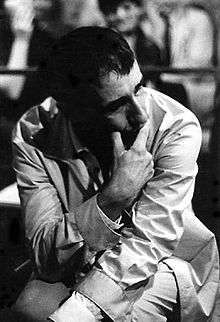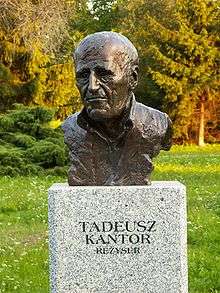Tadeusz Kantor
| Tadeusz Kantor | |
|---|---|
 | |
| Born |
6 April 1915 Wielopole Skrzyńskie, Austria-Hungary |
| Died |
8 December 1990 (aged 75) Kraków, Poland |
| Nationality | Polish |
| Occupation | theater director |
| Notable work | Death Class |
Tadeusz Kantor (6 April 1915 – 8 December 1990) was a Polish painter, assemblage artist, set designer and theatre director. Kantor is renowned for his revolutionary theatrical performances in Poland and abroad.
Life and career
Kantor was born to Marian Kantor-Mirski and Helena Berger. His family were staunch Catholics. His mother was related to composer and conductor Krzysztof Penderecki, through her German father. Born in Wielopole Skrzyńskie, Galicia (then in Austria-Hungary, now in Poland), Kantor graduated from the Cracow Academy in 1939. During the Nazi occupation of Poland, he founded the Independent Theatre, and served as a professor at the Academy of Fine Arts in Kraków as well as a director of experimental theatre in Kraków from 1942 to 1944. After the war, he became known for his avant-garde work in stage design including designs for Saint Joan (1956) and Measure for Measure (1956). Specific examples of such changes to standard theatre were stages that extended out into the audience, and the use of mannequins as real-life actors.
Disenchanted with the growing institutionalization of avant-garde, in 1955 he with a group of visual artists formed a new theatre ensemble called Cricot 2. In the 1960s, Cricot 2 gave performances in many theatres in Poland and abroad, gaining recognition for their stage happenings. His interest was mainly with the absurdists and Polish writer and playwright Stanisław Ignacy Witkiewicz (also known as "Witkacy"). Stage productions of Witkacy's plays The Cuttlefish (1956) and The Water Hen (1969) were regarded as his best achievements during this time. A 1972 performance of The Water Hen was described as "the least-publicised, most talked-about event at the Edinburgh festival".


Dead Class (1975) was the most famous of his theatre pieces of the 1970s. A TV-Movie of the production was made in 1977, directed by Andrzej Wajda. In the play, Kantor himself played the role of a teacher who presided over a class of apparently dead characters who are confronted by mannequins which represented their younger selves. He had begun experimenting with the juxtaposition of mannequins and live actors in the 1950s.
His later works of the 1980s were very personal reflections. As in Dead Class, he would sometimes represent himself on stage. In the 1990s, his works became well known in the United States due to presentations at Ellen Stewart's La MaMa Experimental Theatre Club which inspired Lower East Side cultural leaders such as the Nuyorican poet Giannina Braschi.[1]
Throughout his life, Kantor had an interesting and unique relationship with Jewish culture, despite being a nominal Catholic Kantor incorporated many elements of what was known as "Jewish theatre" into his works.
Kantor died in Kraków.
Major manifestos and writing
- The Autonomous Theatre (1963)
- Theatre Happening: The Theatre of Events (1967)
- The Informal Theatre (1969)
- The Zero Theatre (1969)
- The Theatre of Death (1975)
Productions with Cricot 2
- The Cuttlefish (1956)
- The Country House (1961)
- The Madman and the Nun (1963)
- The Water Hen (1965)
- Dainty Shapes and Hairy Apes, or the Green Pill (1972)
- The Dead Class (1975)
- Wielopole, Wielopole (1981)
- Let the Artists Die (1985)
- I Shall Never Return (1989)
- Today is my Birthday (1990)
See also
References
- ↑ Giannina Braschi. "World Literature Today, What to Read Now: Mixed-Genre Literature, Tadeusz Kantor, by Giannina Braschi". Worldliteraturetoday.com. Retrieved 2012-08-12.
- Kobialka, Michal, ed and trans. "A Journey Through Other Spaces: Essays and Manifestos, 1944-1990." Publisher: University of California Press, 1993. ISBN 0-520-08423-3
- Wilson, Edwin. Goldfarb, Alvin. Living Theatre: A History. Publisher: McGraw-Hill, 4th edition. August 5, 2003. ISBN 0-07-256257-9
External links
- Tadeusz Kantor at culture.pl
- Cricoteka The Centre For the Documentation of the Art of Tadeusz Kantor
- Kantor's gallery at malarze.com
- Demarco European Art Foundation at the Wayback Machine (archived October 25, 2006) images of Edinburgh performances by Tadeusz Kantor
- In Search of Kantor Details of show being performed in Edinburgh 2007 based on Kantor
- Cricot 2's website
- Art Signature Dictionary, genuine signature by the artist Tadeusz Kantor Here are several dated examples of Tadeusz Kantor signature.
- TADEUSZ KANTOR YEAR 2015